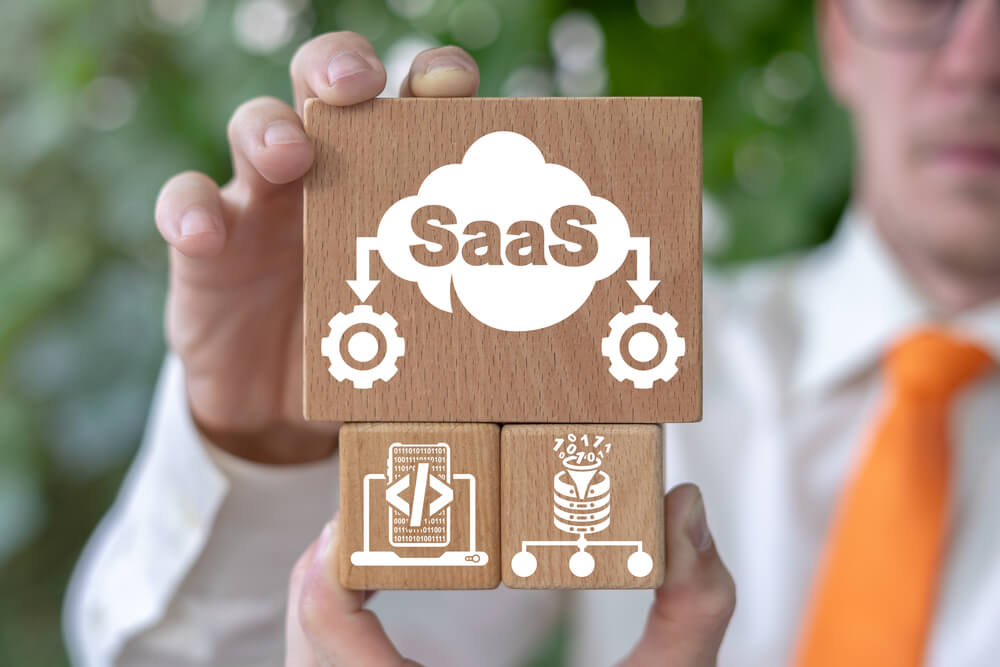
Want High Customer Conversion? Steps To Optimize Your SaaS Website
Most software-as-a-service (SaaS) businesses convert only 5% of their leads to customers. However, studies also reveal that top performers hit 10% or more. How do you become part of the elite?
It begins with your website, and a SaaS marketing agency is your expert partner in optimizing its content, design, and returns.
This article shares three steps that the best marketing teams take. It also discusses the following:
- Difference between a SaaS, professional service, and ecommerce site.
- Challenges most SaaS websites face.
SaaS businesses have unique needs. Marketing should be tailored to them. Read below to learn more.
Let’s go!
Want to know how we help SaaS businesses stand out from the crowd? Watch this video to learn how DAP makes it happen!
How SaaS Websites Vary from Other Industry Pages
Digital Authority Partners (DAP) discussed what makes a SaaS homepage special. Below is a table that lists its primary features and how they differ from those of ecommerce and professional services sites:
| Element | SaaS Website | Ecommerce Website | Professional Services Website |
|---|---|---|---|
| Homepage | - Software introduction - Value proposition - Call to action to sign up - Features and benefits - Customer testimonials - Blog or news section - Contact information - Pricing information - Free trial or sign-up buttons |
- Featured products and promotions - Search bar for products - Product categories - New arrivals and highlights - Customer reviews - Shopping cart summary - Customer support information - Returns and exchanges policy - Contact information |
- Services introduction - Contact information - Call to action for inquiries - Blog or industry insights - Social media links - Case studies or portfolio - Testimonials or success stories |
| Product or service pages | - Detailed product or service information - Pricing plans or packages - Features and benefits - Screenshots or demos - Call to action (sign up or buy) |
- Product descriptions - Pricing information - Customer reviews or ratings - Related products - Add to cart and buy options - Product specifications - Size and color options |
- Service details and features, usually customized according to locations - Pricing and service packages - Trust badges or certifications - Request a quote or consultation - Contact form or inquiry button |
| Customer support | - Help center/knowledge base - Contact form or live chat - User community/forum - Tutorials and documentation |
- FAQs and customer support - Customer support information - Return and exchange information - Contact information |
- Contact information - Support resources and FAQs |
These differences then highlight the unique challenges that SaaS websites must conquer, especially in these areas:
- Conveying product value without tangible goods or in-person services. Unlike physical products, SaaS feels “intangible.” Customers cannot touch, feel, and experience it, increasing doubt and purchase resistance.
- Onboarding and training new users on software capabilities. SaaS requires getting users up to speed on how to effectively use the software. Otherwise, the lack of hand-holding during onboarding leads to churn.
- Getting users to regularly engage with the software after signing up. Unlike one-off purchases, your business heavily relies on habit formation. Your service or product should become vital in the user’s workflow to drive retention and expansion. However, doing this means continual engagement, which is time-consuming and costly.
- Measuring the software’s returns and impact on customer businesses. Some of your metrics, such as improved productivity and time savings, quantify the product’s value to your customers and organization. However, these are harder to measure than physical product margins.
- Integrating your platform with others. SaaS products often must integrate tightly with other complementary software solutions through APIs and customization for a seamless workflow.
- Maintaining support and enhancing software capabilities post-purchase. Unlike finished goods, SaaS must continually add new features, fix bugs, and provide assistance to maintain its perceived value. In other words, its support costs are higher.
Running your SaaS business like a well-oiled machine means optimizing many components beyond sales. Examples are product and research development, financial performance, and even leadership.
Improving your website for maximum conversions is an ideal starting point.
Three Steps in Optimizing Your SaaS Website for Marketing

It takes more than good blog content and a compelling landing page to convert. The best SaaS marketing agency often works with various teams for a more holistic optimization approach. For instance, it collaborates with designers to help enhance the user experience.
The agency also focuses on these three fundamental steps:
1. Craft a Convincing Value Proposition for Positioning
An unclear or generic value proposition fails to differentiate you or effectively connect with the visitor’s needs. Users cannot envision how your product fits into their specific use cases and workflows.
How do you make a winning value proposition, though? Suppose you are a tax filing platform competing against TurboTax. A smart marketing team performs the following:
- Define your target audience. Research your audience to understand their goals, frustrations, and needs. Shape the value proposition around satisfying their wants and expectations. Example: “Busy professionals must do so quickly and correctly.”
- Recognize your target audience’s problem or pain point, which your product solves. Create an emotional connection between their problem and your solution. Taxes are complicated and frustrating. Filling out forms takes time for busy workers, and they could end up making mistakes that they only uncover later, leading to audits or penalties.
- Identify the key benefits your product or service provides. Focus on the specific value offered rather than generic claims. Quantify benefits with data or statistics. Example: “Our platform provides real-time error checking that saves you time and prevents mistakes before filing.”
- Pinpoint your product’s uniqueness compared to competitors. Highlight proprietary technology, special features, better quality, or superior service that differentiates you. Example: “Our tax experts review your return before filing at no extra cost, giving you confidence and peace of mind.”
- Communicate the value clearly and persuasively. Use concise, compelling language that speaks directly to the customer. Include a call to action. Example: “Don’t waste time worrying about tax return errors. Our AI-driven tools guarantee error-free filing, so you can submit quickly and get your maximum refund faster. Download a free trial now!”
The ideal value proposition and positioning always answer every customer’s silent question, “What’s in it for me?” Get this right on your website, and you quickly push leads deeper into the sales funnel.
2. Make Onboarding Frictionless
According to PayPal, 17% of buyers abandon checkout because the process is long. About half leave their carts because the website needs a convenient return method. Either way, your sales flow introduces significant barriers that turn away customers.
Although all businesses experience cart and checkout abandonment, every missed opportunity is a lost sale. It quickly adds up too. Avoid it by making a vital sales funnel aspect – onboarding – frictionless.
Excellent strategies include the following:
- Simplify and shorten signups. Only ask for essential information, such as email and password, to start a trial. Allow them to skip other details that they can fill out later or use their existing social media or email accounts to register.
- Offer free trials. It requires just an email address to get started. Avoid asking for a credit card or payment data at this stage.
- Provide guest checkout options for initial low-commitment purchases.
- Use progress bars in multi-step signup flows to indicate completion progress.
- Autofill forms with presumed contact information to skip tedious typing.
- Structure pricing well. Label them clearly as Basic, Pro, or Enterprise plans. Include a comparison table detailing inclusions.
- Avoid pricing tricks, such as hiding true costs. Be transparent to build trust.
- Offer self-guided product tours and in-app walkthroughs to onboard more experienced and knowledgeable users.
- Provide robust self-help resources to reduce new user questions. Examples are documentation, FAQs, and forums. Use artificial intelligence, such as virtual chat agents (chatbots), to immediately engage leads.
- Send onboarding emails with tips, product news, and reminders to complete their profile.
Seamless, easy onboarding elevates UX, which bodes well in your SaaS digital marketing efforts. Most of all, it uplifts your brand’s perceived value. It showcases your knowledge and empathy for your customer’s needs.
3. Optimize Content for Every Channel and Device
With buyers consuming information across touchpoints, content strategy is no longer just about blogging. Instead, a SaaS marketing agency optimizes assets for a full omnichannel customer journey.
Here is how that works:
- Conduct an extensive content audit. Review blogs, ebooks, whitepapers, case studies, testimonials, brochures, emails, ads, landing pages, and webinars. Identify content gaps for each buyer stage and channel. Look for opportunities to consolidate or improve assets.
- Ensure content displays properly on mobile. Key pages and assets must render responsive layouts on mobile devices without horizontal scrolling or broken layouts. Shorten excessive copy and simplify messaging.
- Incorporate more engaging multimedia. Produce videos that bring products or features to life. Create interactive calculators, assessments, and tools tailored for self-service on-site use. Webinars and demos also help qualify leads.
- Personalize content with dynamic segmentation. Send targeted content to prospects based on role, industry, and behavior using marketing automation and integrated customer relationship management data. Customize onboarding as needed.
- Promote content discoverability and access. Optimize pages and downloadable assets for search engine optimization with keywords, meta descriptions, and alt texts. Cross-link related content. Promote top resources site-wide and in newsletters.
- Analyze content performance to know what works. Assess channel preferences based on content engagement and conversions. Perform A/B tests on specific elements, such as headlines and calls to action. Refine or replace poor performers.
- Map content to prospect journeys. Create personalized nurturing paths with messaging that educates, builds trust, and addresses concerns. Effectively guide prospects.
- Repurpose top assets across formats. Turn popular blog posts into social videos, podcast interviews, and ad campaigns. Maximize value from evergreen assets.
Effective omnichannel content distribution and audience-aligned messaging improve the overall customer journey. It also promotes brand affinity, qualified leads, and loyalty.
Summing Up
As a SaaS business, making your intangible product more believable, immersive, and real to your target market is challenging. A well-designed and optimized website helps address this problem.
When done correctly, it highlights your unique value proposition and guides leads seamlessly through every step of their sales journey. Good content helps them visualize your product’s benefits, while demos and free trials build trust and product value.
This blog post shares three key steps to enhance your site’s conversion. If you need more tailored solutions, contact Digital Authority Partners (DAP) to schedule a free consultation. As an award-winning SaaS marketing agency, we develop strategies that result in higher customer lifetime value and faster business growth.
Want To Meet Our Expert Team?
Book a meeting directly here




